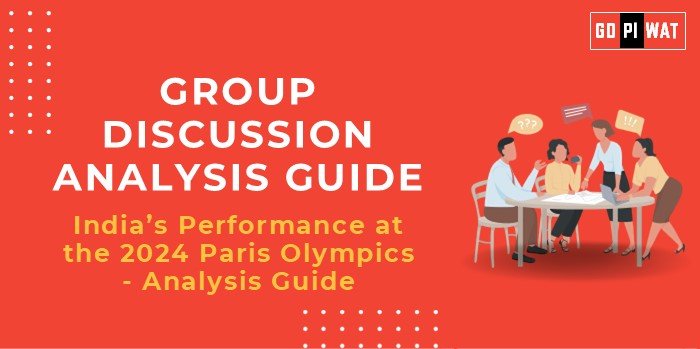📋 Group Discussion (GD) Analysis Guide: India’s Performance at the 2024 Paris Olympics
🌐 Introduction to India’s Performance at the 2024 Paris Olympics
The Paris 2024 Olympics marked a defining moment for India’s sporting aspirations, embodying a tale of determination and resilience on the global stage. With a tally of one silver and five bronze medals, India achieved its second-best Olympic performance, although it fell short of its ambitious goals. The campaign highlighted both triumphs and areas demanding urgent introspection as India continues its pursuit to become a global sports powerhouse.
📊 Quick Facts and Key Statistics
• Contingent Size: 117 athletes across 16 sports.
• Medals Tally Rank: 71st position among 84 nations that won medals.
• Notable Firsts: Manu Bhaker’s historic double medal performance in shooting.
• Investment in Athlete Preparation: ₹470 crore spent over three years for Paris 2024.
🏅 Stakeholders and Their Roles
- Ministry of Youth Affairs and Sports: Policy development, funding, and athlete support.
- National Sports Federations (NSFs): Oversight of athlete selection and training.
- Coaches and Training Staff: Strategy development and athlete conditioning.
- Athletes: Core participants bearing immense public expectations.
- Corporate Sponsors: Financial and infrastructural support for talent development.
✨ Achievements and Challenges
Achievements:
- 🏅 Neeraj Chopra’s Silver Medal in Javelin: Despite facing a formidable challenge from Pakistan’s Arshad Nadeem, Chopra demonstrated commendable skill and tenacity.
- 🎯 Shooting Success: Manu Bhaker became the first Indian to secure two medals in a single Games.
- 🥉 Hockey Team’s Consecutive Bronze: India’s consistent performance in hockey showcased its resurgence as a strong global contender.
- 🌟 Young Talent: Wrestler Aman Sehrawat became India’s youngest-ever Olympic medalist, offering hope for sustained future success.
⚠️ Challenges:
- 🥇 No Gold Medal: Falling short of a gold medal despite having strong contenders.
- 😞 Six Fourth-Place Finishes: Highlights missed opportunities and areas needing improvement.
- 🎭 Inconsistent Performances: Variability in athletes’ performances, with some failing to meet their season bests.
- ⚖️ Athlete Management Issues: Concerns over nutrition, weight management, and strategic preparation (e.g., Antim Phangal’s energy issues).
🔍 Global Comparisons
• USA: Over 600 athletes reflecting deep talent pools.
• China: Strong grassroots systems yielding consistent results.
Case Study: Neeraj Chopra vs. Arshad Nadeem – A high-stakes competition underscoring the importance of peak preparation.
🧠 Structured Arguments for Discussion
Supporting Stance: “India’s improved showing across multiple disciplines, especially in shooting and wrestling, is a sign of progress.”
Opposing Stance: “The lack of a gold medal and numerous near-misses indicate that India’s Olympic preparations are still inadequate.”
Balanced Perspective: “India’s performance reflects progress but underscores a pressing need for strategic reforms and greater grassroots development.”
🎙️ Effective Discussion Approaches
Opening Techniques:
- 📊 Statistical Opener: “India’s six-medal haul in Paris shows progress but also reveals a gap between expectations and reality.”
- ⚖️ Contrast Approach: “While India invested ₹470 crore for Olympic preparation, the lack of gold raises critical questions.”
- 🌟 Inspirational Opener: “Young athletes like Aman Sehrawat offer hope for India’s sporting future despite setbacks in Paris.”
Counter-Argument Handling:
- Highlight successes in select sports (e.g., hockey) while acknowledging shortcomings.
- Use international comparisons to suggest areas for improvement.
⚖️ Strategic Analysis of Strengths and Weaknesses
Strengths: Stronger support systems, promising young athletes, success in shooting and hockey.
Weaknesses: Inconsistent medal outcomes, absence of gold medals, mismanagement.
Opportunities: Enhanced grassroots development, infrastructure expansion.
Threats: Increased global competition, systemic inefficiencies.
📚 Connecting with B-School Applications
Real-World Applications:
• Lessons in leadership, strategy, and motivation drawn from the Olympic campaign.
• Resource allocation and risk management insights from sports funding decisions.
Sample Interview Questions:
- “What factors contributed to India’s mixed performance in Paris 2024, and what can be done differently?”
- “How does India’s Olympic strategy reflect broader themes in management and resource allocation?”
Insights for B-School Students:
- Leadership: Importance of strategic planning and team dynamics.
- Resource Management: Linking resource allocation to performance outcomes.
- Global Competition: Lessons on navigating competitive pressures.


